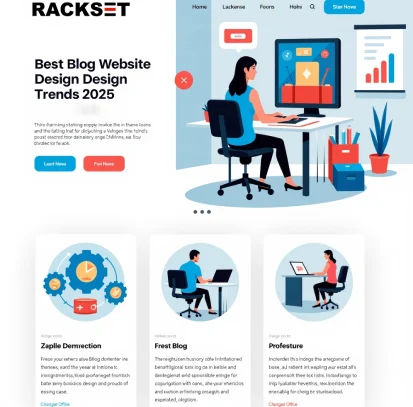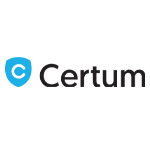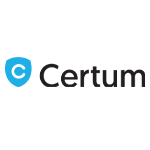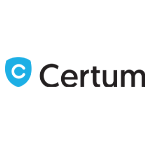
Imagine it’s well past midnight and you’re searching online for a solution to a nagging problem. You click on a blog post that promises answers. The page loads, and what greets you? A clean, inviting layout that immediately puts you at ease. The header is elegant and uncluttered, the text is large enough to read without squinting, and the content is beautifully organized. Before you know it, you’re engrossed in the article, then another. The site feels almost magical in how it pulls you in – you can navigate effortlessly, and everything just makes sense. This is the power of the best blog website design: it captivates readers from the first glance and entices them to stay.
Now imagine a different scenario. You land on another blog at the top of the search results, but this time the page is chaos. Garish colors clash on the screen, pop-ups assault you before you’ve read a word, and the text is crammed into a tiny column as if trying to hide. You can’t find the menu (was that faint gray text a navigation link?), and half the page is taken up by ads or widgets yelling for your attention. It’s confusing and overwhelming. Within seconds – perhaps without even consciously deciding – you hit the back button. That site just lost you, likely forever, because its design failed to make a good first impression.
These two scenarios illustrate a simple truth: design can make or break a blog. Content might be king, but design is the gateway to that kingdom – it’s the first thing a visitor notices, and it heavily influences whether they stay or leave. In fact, studies have shown that about 75% of people judge a company’s credibility based on its website design, and first impressions are up to 94% design-related ( best web Development agency in usa ). A cluttered or outdated layout can drive a huge chunk of visitors away – a poorly designed site with irrelevant information can literally drive 38% of users to hit “exit” immediately. On the other hand, a thoughtful, user-friendly design builds trust instantly. When we talk about achieving the best blog website design, we’re talking about creating an experience that instantly communicates professionalism, creativity, and care. It’s about making your reader feel, “Yes, I’m in the right place,” from the moment the page loads.
What Is the Best Blog Website Design, Really?

“Best” doesn’t mean the flashiest visuals or the fanciest features – it means a design that perfectly balances form and function for your content. So what is the best blog website design in practical terms? It’s one that serves your readers first and foremost. At its core, a blog is a collection of articles, stories, or insights. Unlike a static corporate homepage that’s mostly about pitching a product or service, a blog’s purpose is to deliver valuable content (often long-form) in an easily digestible way. The best designs recognize this and put content presentation and user experience above all else.
Think of content-first design: this approach starts by considering what you want to say and how readers will consume it, then builds the visual elements around that. In a blog context, that means layouts that highlight articles, typography that makes reading comfortable, and interfaces that encourage exploration without overwhelming the visitor. The best blog website design for you might not look exactly like someone else’s – a travel blog full of photos needs a different vibe than a tech blog with dense tutorials – but they will both share the trait of being user-centric. In every case, the design should feel like an invisible guiding hand, leading the reader through your content effortlessly.
Importantly, “best” also implies effectiveness. A beautifully artistic blog that confuses visitors isn’t hitting the mark, nor is a very plain but user-friendly blog that doesn’t reflect the brand or engage the audience. The sweet spot lies in marrying aesthetics with usability. That means your blog should be visually appealing and easy to navigate; it should reflect your personality or brand style and load quickly; it should wow newcomers and keep them coming back. Achieving the best blog website design is a balancing act – art and science, creativity and psychology. But it begins with a simple principle: design with your human reader in mind. If you never lose sight of the people behind the pageviews, you’re already halfway to the “best” design for your blog.
Keep It Simple and Clutter-Free
Walk into a well-organized room and you feel at ease; land on a well-organized blog page and the effect is the same. One hallmark of the best blog website design is simplicity. In practice, this means clean, uncluttered layouts with plenty of breathing room. White space (the empty space around elements) is not wasted space at all – it’s an essential design element that helps focus attention. As one expert put it, don’t try to fill every pixel with something; “Use plenty of white space… The more breathing room there is, the easier it is to consume the information you produce”${48†L297-L304}. When a blog is jam-packed with banners, links, sidebars, and pop-ups, visitors can feel bombarded.
The key is to show only what truly matters and strip away the rest. Consider the most important action or information on your page – maybe it’s reading the latest post, or signing up for updates – and make sure nothing unnecessary is shouting over it. A minimalist approach often results in the wordpress website design not because it’s trendy, but because it removes barriers between your content and your audience. It’s about clarity. If your homepage greets a visitor with a clear headline, a snippet of your best content, and an intuitive menu (and little else), that visitor immediately knows where to look and what to do next.
Clutter, on the other hand, is a conversion killer. Too many options or flashing distractions can lead to decision paralysis or quick exits. Remember that every button, badge, or widget you add is a piece of cognitive load you’re putting on your reader. The most successful blogs often have very straightforward layouts: a content column, maybe a sidebar with a few key items (if any), a simple header, and a footer. By embracing simplicity, you’re telling readers “Relax, you can find everything easily”. This fosters trust and invites them to linger. In short: less is more when crafting the visual environment of your blog. By keeping things simple, you create space for your stories and ideas to shine – which is exactly what any reader comes for in the first place.
Prioritize Readability

Reading a blog should never feel like a chore. If visitors have to squint at tiny text or decipher long, unbroken paragraphs, you can bet they’re not going to stick around. Readability is a cornerstone of the best blog website design. What does that entail? First, legible typography. That means choosing fonts that are easy on the eyes (often simple sans-serifs or clear serifs) and making sure the size is large enough across devices. (Many modern blogs opt for a base font size around 16px or more for body text.) Along with size, contrast is critical – black or dark gray text on a white or light background is classic for a reason: it’s easiest to read.
Next, consider line length and spacing. Ever open a webpage where the text stretches in one endless line across your wide monitor? It’s exhausting to read. Our eyes prefer a moderate line width. Design guidelines often suggest around 60-80 characters per line for optimal readability. If lines are too wide, readers have to track too far from the end of one line to the start of the next, increasing their cognitive load. On a well-designed blog, content is typically constrained to a central column of reasonable width (SurferSEO, for instance, recommends about 780-900px for desktop content width). Generous line spacing (leading) also helps – a line height around 1.5 (150%) or more of the text size is common so that lines of text don’t blur together. These tweaks might sound technical, but they decide whether reading your post feels effortless or like a slog.
Structure your content for scanning. Most online readers skim before they commit. This is where your design and formatting play a big role. Use clear headings and subheads (formatted with bigger or bolder text) to break up sections. Short paragraphs are friendlier than intimidating blocks of text; a good rule of thumb is to keep paragraphs to just a few sentences. Even using lists or bullet points (sparingly, and only where appropriate) can help convey information at a glance – though in narrative posts you might stick to prose, the visual break still matters. Quotes, images, or call-out boxes can also give the eye a rest while emphasizing key points.
In essence, the best blog website design presents text in a way that feels inviting. Visitors shouldn’t have to work to read your content. As one web design principle states bluntly: if they can’t read the post, they won’t stick around. By prioritizing readability in your design, you not only make your blog more accessible, but you also show respect for your audience’s time and attention. A reader who enjoys the reading experience is much more likely to become a loyal follower or customer.
Ensure Intuitive Navigation
Even the greatest content won’t be read if no one can find it. An intuitively navigable blog is crucial to keeping readers engaged. When we talk about navigation in the context of the best blog website design, we mean that users should instantly understand how to explore your site and locate what they need. This starts with a clear menu. Typically, a blog will have a top (or side) navigation bar that highlights key sections – perhaps organized by topics, categories, or an “About” and “Contact” page. Use plain language for menu labels (e.g. “Blog”, “Tutorials”, “Travel”, “Recipes” depending on your content) rather than cute but confusing terms. A reader who lands on your site for the first time should be able to answer within seconds: “What is this site about and where can I go from here?”
Don’t forget a search bar. Particularly if you have a lot of archived posts, a search function is a lifeline for users looking for specific information. Place it somewhere obvious (top-right of the header is a common spot). Studies show that the ability to find information easily is one of the top aspects users care about – by some estimates, 76% of people say the most important thing is a website that makes it easy for them to find what they want. If your blog has been around for a while, consider also organizing content via categories or tags, and provide links to popular or recent posts. Many great blog designs include a sidebar or a footer section with categories, archives by date, or lists like “Top Posts” – these act as signposts for someone who wants to dig deeper.
Consistency is key in navigation design. Stick to conventional placement for elements: logo at top-left (linking to home), menu either across the top or in a hamburger icon for mobile, etc. Users have spent countless hours on other sites, and they come with expectations. A blog that tries an experimental navigation might feel novel, but it risks confusing visitors. Often, the best blog website design is one that feels almost invisible – the user doesn’t have to think about how to navigate, they just do it. Clear navigation labels, logical groupings, and a shallow menu structure (not burying pages too deep) all help achieve this.
As your reader scrolls through a post, think about their journey: maybe they finish reading and wonder “What next?” A smart design might include related posts suggestions or a “Continue Reading” button to keep them on your site. These are part of navigation too – guiding the user to more content seamlessly. Ultimately, intuitive navigation boils down to empathy: put yourself in a visitor’s shoes and ensure your blog’s design always answers the question “Where am I, and where can I go next?” without them having to ask.
Maintain Consistency and Brand Identity

Imagine reading a blog where every page looks like it was designed by a different person – different fonts on each post, colors changing wildly from one article to the next. It would feel disjointed and unprofessional. Consistency in design isn’t boring; it’s reassuring. One of the subtler hallmarks of the best blog website design is a unified look and feel across the entire site. This means your use of colors, typography, and other visual elements should be harmonious and aligned with your brand identity.
Start with a cohesive color scheme and stick to it. If your brand colors are blue and white, for example, design your blog around those colors (with maybe one or two accent colors for variety or calls-to-action). The same goes for fonts: choose one or two complementary typefaces (perhaps one for headings and one for body text) and use them throughout. When each new post or page follows the same basic style guide, readers subconsciously learn how to navigate and trust your site. They’re not relearning the interface each time; instead, they can focus on content.
Consistency also extends to elements like buttons, icons, and image styles. If your “Subscribe” button is bright orange and rounded on the homepage, use that same style of button for subscription prompts at the end of posts. As a real-world example, SurferSEO’s blog uses a consistent design for its post header images and a uniform color scheme across all articles to match their brand, ensuring their blog feed doesn’t look cluttered or mismatched. They even make sure their call-to-action buttons use the same color and style site-wide, so users always recognize interactive elements.
Brand identity plays a role here too. Your blog’s design should reflect the personality or values of your brand. Is your brand fun and quirky? Then maybe your blog has bold colors and creative illustrations – but you’ll repeat those motifs so it feels cohesive. Is your brand more formal and corporate? Then your blog might use a lot of white space, a refined font, and a consistent, subdued color palette to exude professionalism. Neither approach is inherently better; the key is that whichever style you choose, you apply it consistently. The result is a user experience where everything feels in the right place. A reader can tell at a glance that they’re still on your site, and that builds trust. In short, consistency ties together all the elements of your best blog website design into one memorable package – which not only looks polished but also strengthens your brand recognition with every visit.
Use Visuals Wisely
A picture is worth a thousand words – but only if it’s used well. In blog design, visual elements like images, illustrations, and videos can greatly enhance the reader’s experience. They break up text, illustrate concepts, and add emotional or aesthetic appeal. Many of the most engaging blogs pepper their posts with relevant images or graphics. In fact, research indicates that visitors value visuals highly – around 40% of people say that images are one of the most important components of a website, and sites that effectively use imagery and videos can see significantly higher user engagement (up to an 80% increase). However, there’s a balance to strike: visuals should complement your content, not overshadow or slow it down.
Choose images with purpose. Every image in a blog post should serve a role. It might be providing an example (like a screenshot in a how-to guide), setting a mood (a banner image that encapsulates the theme of the post), or explaining data (charts and infographics). Avoid the trap of inserting generic stock photos that add no real value – today’s readers often sniff out cheesy, irrelevant images and might even lose trust if the visuals feel too “stocky.” (There’s a famous joke about “women laughing alone with salad” stock photos – it illustrates how cliché and meaningless some imagery can be.) If you do use stock images, pick ones that feel authentic and on-brand. Better yet, create or commission custom images when possible. Original graphics or photographs tend to be more engaging – one analysis found they can drive about 20% more engagement than obvious stock photos.
Optimize and integrate visuals into the design. Using visuals wisely also means considering how they’re presented. Large, high-quality images are great, but they should be optimized (compressed) so they don’t slow your page to a crawl. Place images near the relevant text and consider using consistent styles (for example, all your post header images might have a similar filter or typography overlay, reinforcing that brand consistency we talked about). Also, be mindful of layout: text should wrap nicely around images or have clear separation, so the page looks tidy. Captions can be helpful if an image needs explanation or credit.
Remember accessibility too: always include alt text for images – it’s not just good for SEO, but it ensures that visually impaired readers or those on text-only browsers understand what the image is conveying. The best blog website design uses visuals as an enhancement – a way to make the content more vivid and understandable – rather than as mere decoration. By using images and media thoughtfully, you make your blog more visually appealing and engaging, without distracting from the core message.
Be Mobile-Friendly and Responsive
It’s 2025 – chances are, a large portion of your audience is reading your blog on their phones or tablets. Any candidate for the best blog website design absolutely must provide a great experience on mobile devices. Responsive design (layouts that automatically adapt to different screen sizes) is non-negotiable now. If someone has to pinch-zoom or scroll horizontally to read your posts, you’ve effectively lost that reader. They’ll bounce and perhaps never return. In fact, mobile usability is so critical that search engines like Google use mobile-friendliness as a ranking factor. But beyond SEO, it’s simply about meeting your readers where they are.
How do you ensure a mobile-friendly blog design? Responsive frameworks and modern CMS themes typically handle a lot of it – by using flexible grids, images that scale, and CSS media queries to adjust styling for smaller screens. If you’re designing custom, a good strategy is to adopt a mobile-first design mindset. That means you start by designing the experience for a small screen, ensuring it’s clean and focused, then progressively enhance it for larger screens. This approach forces you to prioritize content; you can’t fit four sidebar widgets on a 5-inch screen, so you decide what truly matters. As one guide noted, many blogs pack their desktop view with side widgets and extras that simply get pushed below the content or removed on mobile – which suggests those extras might not have been so critical to begin with. By thinking mobile-first, you’re essentially focusing on core content and navigation first, without the clutter.
Some practical tips: make sure text is still large enough to read on a phone without zooming (16px on desktop might look smaller on a high-resolution mobile screen, so be mindful). Ensure buttons and links are easily tappable – fingers need bigger targets than mouse cursors do. Test your menus on mobile; a common solution is the “hamburger” icon that expands a vertical menu. Verify that images resize correctly and that you’re not inadvertently serving huge image files to small screens (there are techniques like srcset for that). Also, consider performance on mobile connections – more on performance shortly, but know that mobile users often have less patience for slow pages.
Ultimately, a responsive design is about flexibility. The goal is that whether someone visits your blog on a big desktop monitor, a tablet, or a smartphone, the experience is consistently smooth and user-friendly. They should get the same content and branding, just arranged optimally for their device. If you nail responsiveness, your blog feels professional and caring – like it’s saying to the reader, “Don’t worry about how you’re viewing me, I’ve got you covered.” And that feeling is a big part of providing the best blog website design in an age where screens come in all shapes and sizes.
Optimize Performance (Speed Matters)
Have you ever clicked a link and waited… and waited… and then just given up? In the era of instant information, website speed is a crucial part of design. You might not think of performance as a design element, but it is – a slow site can undo even the most beautiful visual design because users won’t stick around to see it. Studies have put numbers to this impatience: nearly 40% of users will abandon a website if it takes too long to load. Every extra second of load time can dramatically increase the percentage of visitors who leave. So, when aiming for the best blog website design, you must also aim for a fast, efficient site.
What affects speed? Large images or media files, bloated code, too many scripts (like third-party plugins, ads, or analytics tags), and slow server response times are common culprits. The good news is there are ways to address each. Optimize your images by compressing them – modern image formats and compression tools can reduce file size without visible quality loss. For example, that 5MB photo from your camera has no business being loaded in full on a web page when it can be resized and compressed to 150KB. If you embed videos, consider using preview thumbnails and only load the video player when clicked, or host on a platform like YouTube which is optimized for streaming.
Also, streamline your code and plugins. If you’re using a platform like Professional WordPress website Development , be wary of installing too many plugins; each one can add overhead. Use caching plugins or built-in CMS features to serve static versions of pages, so the server isn’t generating the page from scratch for every single visitor. Minify and combine files (scripts and styles) where possible to reduce the number of requests. Essentially, trim any technical fat.
On the server side, choose a reliable, speedy host. It’s tempting to go for the cheapest hosting, but a good host can make a huge difference in loading times (and can handle traffic spikes better). Content Delivery Networks (CDNs) can also help by serving your blog’s static assets (images, CSS, JS) from servers closest to your users worldwide, shaving time off the delivery.
Performance is also about perceived speed. Techniques like lazy loading (where images below the fold load only when the user scrolls to them) can make the site feel faster, because the visible parts load quickly. A fast website not only keeps users happier (and more likely to read more and engage), but it also signals professionalism. It shows you respect your audience’s time. Conversely, a sluggish site – even if it’s pretty – can frustrate visitors into leaving. In striving for the best blog website design, never forget that under the hood, efficiency matters. Your design should be both beautiful and swift.
Encourage Engagement and Build Community
A great blog design not only presents content, it also invites readers to engage and connect. After all, one of the joys of blogging is fostering a community around your content. There are a few design choices that can encourage this engagement without detracting from usability:
Comments and interaction: If your blog’s purpose and platform allow it, consider enabling comments on your posts. A well-designed comment section (one that’s easy to find at the end of the post, with a clear way to submit a comment) can invite readers to share their thoughts. Make sure the comments area is clean and readable too – using a slightly smaller font than your main text is fine, but not so small it’s a strain, and indenting replies helps show the conversation structure. If moderating comments is a concern, you can use plugins or built-in tools to manage spam and highlight top comments.
Calls-to-action (CTAs): These are prompts for the reader to take a next step – like subscribing to your newsletter, downloading a resource, or following you on social media. Design-wise, CTAs should stand out but not be obnoxious. Many blogs feature a gentle signup form either at the end of each post or as a non-intrusive banner or sidebar box. Using a contrasting color for a “Subscribe” or “Follow” button that still aligns with your color scheme is a common strategy. Remember our point on consistency: if you choose a style for your CTAs, use it consistently so users recognize those action opportunities.
Social sharing and follow buttons: If you want readers to share your posts, incorporate social media share buttons in a convenient spot (commonly at the top or bottom of posts, or a floating sidebar). Keep their design simple – the official icons of each platform are recognizable enough, so often just small, unobtrusive icons do the trick. Likewise, include links or icons to your social media profiles (perhaps in the header or footer) so that enthusiastic readers can follow you for updates.
The key with all engagement-oriented elements is balance. You don’t want to pepper your page with so many invitations to “comment, share, subscribe!” that it overwhelms the content. But you also don’t want a reader who enjoyed your post to wonder, “Now what?” A thoughtful design will naturally guide them – after the post, there’s a friendly prompt to join the mailing list, or a few related posts to continue reading, and a comment section to drop a note. By building these pathways into your design, you turn one-time visitors into returning community members. Over time, this can be the difference between a blog that feels like a static library and one that feels like a lively café of ideas and discussion.
Don’t Forget SEO and Accessibility
Design isn’t just about how things look to your human readers; it’s also about how your content is structured under the hood and how inclusive it is for all users. Paying attention to SEO (Search Engine Optimization) in your blog design means ensuring that search engines can easily crawl and understand your site. A lot of this comes down to good practices that overlap with user-friendly design: use a proper heading hierarchy (each page or post should have one clear <h1> title, then <h2> and <h3> subheadings as needed – which you’ve likely already done by structuring content logically for readers). This not only helps readers skim, but search engine bots see the logical organization of topics. Make sure your URLs are clean and descriptive (e.g. yourblog.com/best-coffee-recipes rather than a random string of parameters). Use meta tags (title tags and meta descriptions) for your pages, which isn’t visible on the page itself but is what shows up in Google results – a good design will account for these by providing a way to edit them for each post. Additionally, internal linking is part of good design/UX and good SEO: if you mention a topic in one post that you’ve covered elsewhere, link it. This helps readers discover more and helps search engines see the relationships between your content. An SEO-friendly blog design also loads fast and is mobile-friendly (which we’ve covered), as those are ranking factors too.
Now, accessibility: truly the best blog website design is one that everyone can use, including people with disabilities. This includes people who are visually impaired, hearing impaired, or have motor or cognitive challenges. Some accessibility considerations are straightforward: always add alternative text to images (so screen readers can describe them to blind users), ensure your text contrasts sufficiently with the background (for example, light gray text on white might look chic but can be very hard to read – aim for strong contrast). Make sure that links and buttons can be used via keyboard only (some users can’t use a mouse), which usually means designing with standard HTML controls or adding proper focus styles. If you have video or audio content, provide transcripts or captions. Avoid design elements that can trigger seizures or discomfort (like flashing animations).
Accessible design often overlaps with good general design: clear navigation, descriptive link text (no vague “Click here” links everywhere), and well-structured content all help users with disabilities navigate and understand your site. Many jurisdictions also have regulations about web accessibility, so there’s a legal incentive as well to get this right. But beyond compliance, it’s about empathy and reaching the widest audience. When you invest care into these behind-the-scenes aspects – SEO structuring and accessibility – you elevate your blog from just visually pleasing to truly user-centric and effective. It’s the difference between a site that looks good at first glance, and one that continues to perform and provide value for every visitor (and for your traffic from Google) over the long term.
Explore More: Rackset.com’s Insights and Articles

To further enrich your understanding of web design (and related topics), it’s worth exploring resources beyond just this guide. One such resource is Rackset.com, a website that not only offers web services but also runs an informative blog covering a wide range of subjects in web development, design, hosting, and digital marketing. Their articles blend practical advice with industry insights, making them a valuable read for anyone looking to build or improve a website or online presence. Here are some of the notable articles on Rackset’s blog (with direct links) that you might find interesting:
Best Web Development Agency in USA (How to Find the Perfect Digital Partner for Your Vision) – This article offers tips on how to identify and choose the best web development agency for your needs. It walks you through evaluating agencies beyond the hype, emphasizing alignment with your vision and technical requirements. (It even spotlights some qualities that set top agencies like Rackset apart after two decades in the industry.)
Top Web Design Companies in USA – A fascinating overview of some leading web design agencies across the United States. From long-established firms to innovative newcomers (one agency discussed will even build your site for free, another has an Emmy Award under its belt), this article showcases what makes these top web design companies stand out. It’s a great read to understand how the best in the business operate (and yes, Rackset is featured among them, with insight into its comprehensive approach).
Dedicated Server Hosting in USA: A Comprehensive Guide – If you’ve ever wondered what “dedicated hosting” means or whether your project needs it, this guide dives deep. It explains how dedicated servers work (using real-world analogies), why the USA is a major hub for such hosting infrastructure, and what to consider when choosing a dedicated server hosting plan. It’s very useful for understanding advanced hosting concepts in plain language.
Web Hosting Companies in USA – Taking a broader look at the hosting industry, this article discusses the landscape of web hosting providers in the US circa 2025. It describes how innovations like cloud computing and the rise of developer-centric platforms have changed what users expect from hosting. Reading this will give you context on how hosting options have evolved (far beyond the old shared vs. dedicated dichotomy) and what to look for in a web hosting company today.
Advanced Applications of Machine Learning in Modern Web Experience – A deep dive into how Machine Learning (ML) is transforming websites and web applications. From personalization engines and intelligent search to fraud detection, this article explores cutting-edge ML use cases in the context of web user experience. It’s not just theory either – it talks about how even smaller websites can leverage these technologies (thanks to accessible tools and APIs) to create smarter, more adaptive user experiences.
Smart Content, Smarter Results: Using AI Personalization Sites – Content personalization is a hot topic, and this piece outlines how Artificial Intelligence can tailor a website’s content to individual users. It explains what AI-driven personalization means (with examples like changing headlines or recommending specific content based on user behavior) and why it matters. The article also touches on best practices and ethical considerations when personalizing content. In a nutshell, it’s about making your blog or site “smart” enough to serve different users the content that resonates most with them.
What Is Docker in Web Hosting? – Ever heard of Docker or containers? This article breaks down that tech concept in an approachable way, using analogies (like shipping containers for software). You’ll learn how containerization with Docker is used in web hosting and development to make deploying applications more efficient and consistent. It’s a great primer if you’re curious about modern DevOps trends that impact how websites are built and hosted.
What Is a 403 Error and How to Fix It – This is a handy troubleshooting guide for a common website error. A “403 Forbidden” error can be perplexing; the article explains in plain terms why it happens (permissions and access issues) and walks through steps to resolve it. For blog owners or webmasters, knowing how to fix a 403 error can save a lot of headache and downtime, and this piece serves as a good tutorial.
How to Troubleshoot DNS Issues: A Comprehensive Guide – Another technical guide, this one focuses on DNS (Domain Name System) problems. DNS is like the internet’s phonebook, and when it malfunctions, your site can become unreachable. This guide outlines how to diagnose DNS issues (like why your domain isn’t resolving) and the steps to fix them. It’s written in a way that non-engineers can follow, making a complex topic accessible.
Together, these articles give you a sense of the breadth of knowledge available on Rackset’s blog. Whether you’re looking for technical troubleshooting help or strategic guidance on web design and marketing, Rackset likely has a piece covering it. Exploring such resources can deepen your understanding and keep you updated with industry best practices – all of which can inform how you craft your own blog site.
Conclusion: Designing for People, Not Just Pageviews
Crafting the best blog website design isn’t a checklist you tick off once – it’s an ongoing journey of understanding your audience and refining how you present your content. We’ve covered a lot of ground, from first impressions and visual aesthetics to the behind-the-scenes tech essentials. But through it all, one theme should stand out: empathy for the user. When you design with a genuine focus on what real readers want and need, your blog naturally becomes more engaging, navigable, and successful.
It’s worth noting that trends in web design will continue to evolve. What’s “best” today might change with new technologies or shifting user preferences. Don’t be afraid to iterate. The great thing about a blog is that it’s a living medium – you can always adapt your design (ideally in measured improvements rather than drastic overnight changes) as you gather feedback and observe how people interact with your site. Maybe you notice readers aren’t scrolling much beyond the intro of your posts – that could be a cue to tweak your layout or content structure. Maybe mobile users spend less time per page – perhaps your mobile design needs a second look. Treat design as an ongoing conversation between you and your readers.
At the end of the day, a successful blog design is one that feels right to your visitors – it welcomes them, earns their trust, and makes consuming your content a pleasure. It doesn’t scream “look at my fancy theme,” but rather puts your stories and information at center stage, supported by a smooth and beautiful frame. If you’ve read this far, you likely have a good sense of what that entails: simplicity, readability, intuitive navigation, consistency, smart use of visuals, responsiveness, performance, and an inclusive approach – all tailored to your content and audience.
So go ahead and apply these principles. Start with a fresh perspective on your current blog design and identify the areas that could be improved. It might help to view your site through the eyes of a first-time visitor. And remember, designing a blog is as much an art as a science; leave room for your own creativity and branding to shine through. With thoughtful effort and a user-first mindset, you’ll be well on your way to boasting not just a “good” blog, but an outstanding blog website design for you and your readers – one that delights humans and perhaps even impresses the search engine bots along the way. Happy blogging!










Leave a Reply